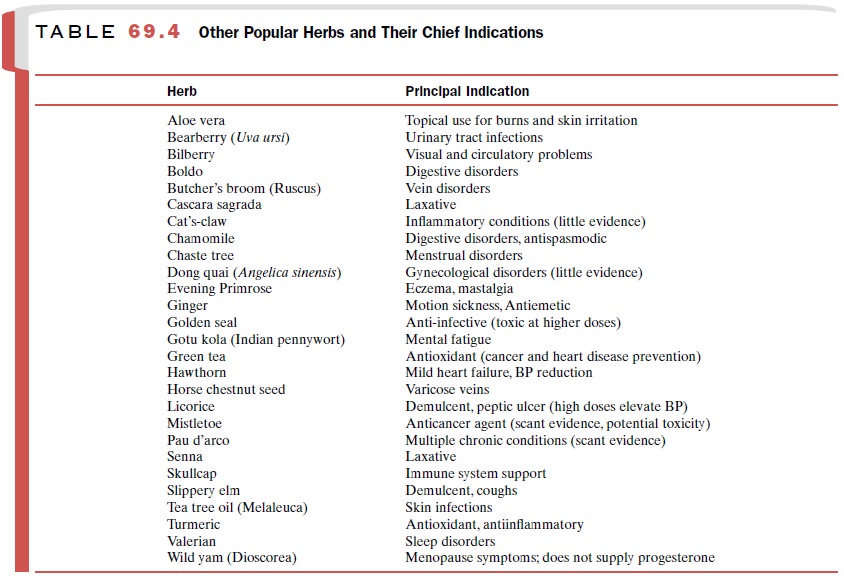Chapter: Modern Pharmacology with Clinical Applications: Herbal Medicine
Herbal Preparations: Soy and Other Phytoestrogens
Soy and Other Phytoestrogens
Soybeans (Glycine max) are protein-rich legumes
widely grown around the world as a food crop. They are the major dietary source
of isoflavones, which are bro-ken
down in the intestine into the phytoestrogens genis- tein and daidzein. It
is believed that the lower risk of breast
cancer, cardiovascular disease, and osteoporosis in Asian women is partly due
to their high soy diet, since these benefits are lost when they adopt Western
dietary habits. Flaxseed, from flax (Linum
usitatissimum), is the source of another type of phytoestrogen, lignan, as well as linolenic acid and
omega-3 fatty acids. Red clover (Trifolium
pratense) contains isoflavones as
well as coumarin and produces effects
somewhat similar to those of
diethylstilbestrol. The negative effect of red clover on sheep fertility
threatened the economy in New Zealand at one time.
Perhaps the most marketed
herbal phytoestrogen is black cohosh, or black snakeroot (Cimicifuga race-mosa), a tall woodland perennial with white
torchlike flowers native to eastern
North America. The rhizome contains triterpene
glycosides and many other ingredi-ents that appear to have phytoestrogenic
effects. Other traditional herbs sometimes promoted as phytoestro-gens, such as
dong quai (Angelica sinensis), have
little medical evidence to support their use.
Mechanism of Action
Soy isoflavones appear to act
as selective estrogen recep-tor
modulators in that they can occupy and block the - estrogen receptor. In premenopausal women with nor-mal estrogen
levels, soy therefore would have an overall antiestrogen (estrogen blocking)
effect, whereas in postmenopausal women lacking estrogen, a weak estro-genic
effect would be observed. Soy may also increase the excretion of bile acids and
lower cholesterol.
The mechanism of black
cohosh’s phytoestrogen ef-fect is unclear, although it may also inhibit
estradiol binding to estrogen receptors. It does not appear to con-tain
isoflavones like soy, and there are conflicting find-ings on its estrogenic
activity. Early reports of luteiniz-ing hormone suppression have been
contradicted by more recent research showing no change in go-nadotropins or
estradiol. There appears to be no stimu-latory effect on estrogen
receptor–positive breast can-cer cells.
Indications
Soy is possibly effective in
reducing menopausal symp-toms, such as hot flashes, although it is much less
effective than estrogens for this purpose. Higher isoflavone doses than are
typically achieved in the U. S. diet are necessary to protect against
osteoporosis. High isoflavone soy pro-tein intake outperformed lower isoflavone
supplements in this regard. Ipriflavone,
a semisynthetic isoflavone, is effective in the treatment and prevention of
osteoporosis and is used for this purpose in Europe and Japan. In the United
States, the FDA has approved the use of soy in conjunction with a low-fat diet
for cholesterol reduction. There also is evidence that diets high in soy
protein re-duce the likelihood of prostate cancer. There is much less evidence
available regarding the effectiveness of red clover and flaxseed; however, they
too appear to hold some promise for menopausal symptoms, lipid reduction, and
prostate cancer.
Black cohosh (Remifemin preparation) appears mod-estly
effective in menopausal symptom relief, according to several German studies of
up to 6 months’ duration; however, more research is necessary before it can be
rec-ommended as an estrogen alternative. Black cohosh is less effective than
estrogen for symptom reduction and is not known to have any effect against
osteoporosis.
Adverse Reactions, Contraindications, and Interactions
While soy is generally
considered safe, it may induce nausea,
bloating, and allergic reactions (itchy
rashes or even asthma if inhaled as
dust) in some people. One study suggested that high midlife soy (tofu)
consump-tion may be associated with cognitive
decline in later life. However, educational and social differences be-tween
the high- and low-tofu groups may also account for some of these findings.
Research findings in regard to the safety of soy in breast cancer patients
conflict, with an in vitro study suggesting possible stimulation of
estrogen-dependent breast cell cultures.
Black cohosh may cause
nausea, vomiting, hypoten-sion, and even miscarriage. It is absolutely
contraindi-cated in pregnancy. Red clover contains coumarins and should
therefore be avoided with anticoagulants. Diets high in red clover isoflavones
have reduced livestock fertility and theoretically could do the same in humans.
Flaxseed may cause nausea, diarrhea, and
flatulence. Cyanogenic nitrates in flax (especially in immature seed pods)
have produced toxic reactions.
Dose
Soy protein doses of 20 to 60
g daily are used to reduce hot flashes and to lower elevated cholesterol.
Higher doses of isoflavones (2.25 mg/g soy protein) or more than 60 g soy
protein may help prevent osteoporosis.
Black cohosh root doses vary
widely, with up to 2000 mg/day of root being taken several times daily. Remifemin is the best-studied brand, and
tablets con-taining 40 mg of black cohosh extract with 1 mg of triterpenes are
given as one or two tablets twice daily.
Conclusions
Soy appears to have weak
estrogenic activity when taken after menopause but may block the effects of
more potent estrogens (thereby reducing breast cancer risk) when used before
menopause. It can reduce menopausal symptoms but is less effective than
estro-gen in this regard. Although long-term high soy diets may help prevent
osteoporosis, it is likely that most U. S. women will not consume enough to be
adequate for osteoporosis treatment. Semisynthetic or concentrated isoflavone
preparations may play a role in the future.
Black cohosh may reduce menopausal
symptoms, and it appears safe and well tolerated for at least a 6- month
period. It lacks the other proven benefits of es-trogen, however. There is less
information to recom-mend red clover and flaxseed, although they remain widely
used for this purpose.
A listing of other popular
herbs and their proposed actions is given in Table 69.4.

Related Topics